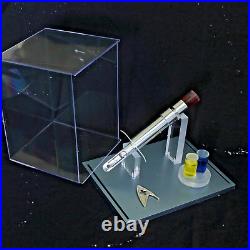
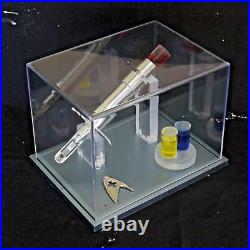
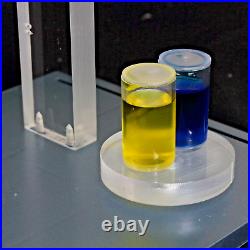
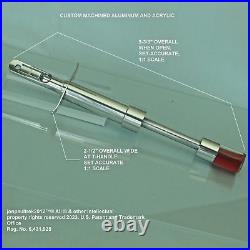
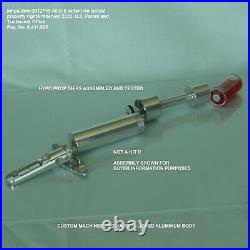
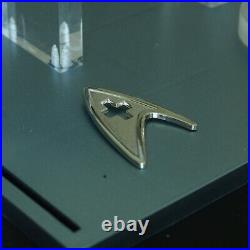
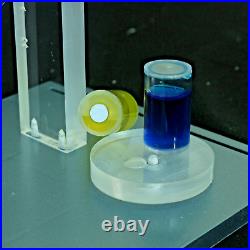
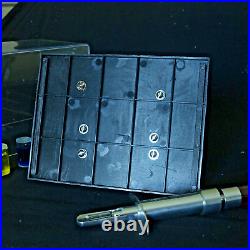
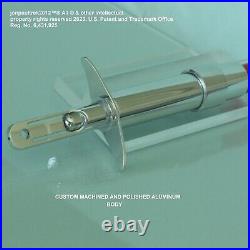
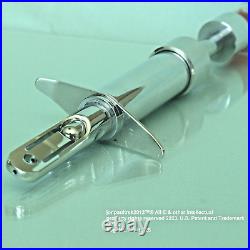
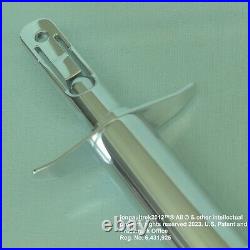
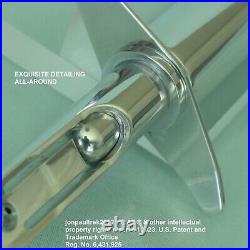
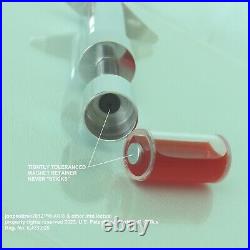
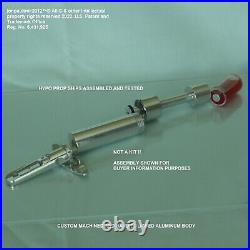
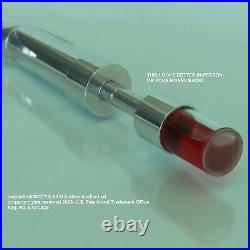
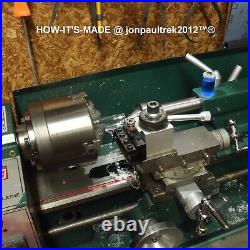
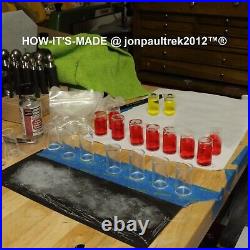
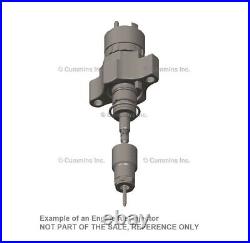


McCoy's Hypo Display with Dust Cover # 4. Three Removable Magnetic Viales, (Red, Blue, Yellow). Machined Aircraft Grade Aluminum & Acrylic. The Hypo & Viales, Plato's Stepchildren Episode Color Set. Hypo and other parts are machined from aircraft-grade aluminum. Set accurate size, materials, and details, just like on-set in the 1960's.
Overall dimensions are in the photos of this listing. Details are exquisite and the finish is an unmatched mirror polish. Prop Hypo is assembled with threads, and not glued, in case the user wants to field strip it but why strip it? I call this full-color group (Red, Blue, Yellow) the Plato's Stepchildren Set as all three colors appear in the episode as Dr. McCoy prepares to give an injection during the episode's start (as seen on a small table as McCoy prepares Vials). The hypo vial is machined acrylic with; red (the most common screen-used color), yellow (as seen in Plato's Stepchildren Episode), and, blue (as seen during both Plato's Stepchildren Episode, and Wolf In The Fold Episode). All vials contain non-toxic distilled water and safe food coloring.
That is just never gonna happen. The lubricant inside the plunger casing is non-toxic Vaseline Brand petroleum jelly. Removable Vile is secured with a recently revised stronger magnet (we went to a stronger magnet to respond to customer feedback). Unlike many similar replicas, on my Prop you do not have to be. To remove the vial (LOL). The Hand Crafted Custom Display.
Overall nominal dimensions of Case: (in inches) 8 wide x 6 deep x 6 high. Machined and laser-cut from acrylic sheet.
Base is painted in metallic McCoy Blue (recalls his satin medical tunic). Base features chrome-plated medical badge based on TOS style. Entire display is machine-screwed together for long life.
See photos for a special detail we added on just the first one of two! Is a medical device from the science fiction television series.
It administers medication subcutaneously and intramuscularly. The fictional Hypospray is extremely versatile, as the medicine vials can be quickly swapped out from the bottom of the Hypospray. As the Hypospray is bloodless, it is not contaminated by use. This allows it to be used on many people until the supply of medicine runs out. Whitfield SE, Roddenberry G (1991) [1969].
Okuda, Michael; Okuda, Denise (2016). Star Trek encyclopedia: a reference guide to the future. As Researched By Episode Views and, on Memory Alpha.
Controls at the injection head set the dosage to be injected. SEDATIVES (Red Vials and Blue Vials). Patant and Trade Mark Information, Toy Patent. Some Other Star Trek Prop History For Inquiring Minds.
Most of these Prop Makers and Technicians have passed-on. Below are old-timer accounts of convention conversations before conventions were really a fad. (all these are therefore 2nd hand stories). The persons quoted worked for; Desilu ®, NBC ®, Paramount ® & Gene R. Bob Stone was Star Trek's machinist and made all the metal prop parts for all three seasons of the show. Parts were made to order for each episode as in those times (the 1960's) as machining was done by hand and there was no advantage to making short runs (and no studio funding either). Each episode had a specific budget.
Sometimes it was not that a new design was needed but rather that when one Wings it from a sketch, in a hurry using what is on-hand, you get an unintended-new-version of something (in the 1960's the TV audience never could see that). Robert Archer and Bob Stone worked closely together so when the show was canceled suddenly in season three, Robert Archer ended up with a nice collection of hand props. Richard Heimer made the molds for hand props. He also did all the casting and forming. This included; Vacuum form bucks, Fiberglass molds and urethane molds. Again, according to him most work is done in the normal Hollywood maddening rush. He shared with his convention friends that there were many molds made from molds when the production schedule demanded this. He also shared that when the show ended he rescued the molds from being discarded by putting them in his garage.
1919 was the director of special effects for the show. He handled and repaired many of the props on-set. When the show was canceled in season three he rescued many hand props and even some models from the scrap heap. Dick Ruben, Prop & Art Assistant on the show, got his Set-Used Klingon disruptor from James. Ruggs held on to his rather large Star Trek collection for many years.
It is widely known that Greg Jein got his Holy-Grail Hero Phaser from James. In closing a nod to Mr. Ruck, a prop technician, who reported that he repaired some hand props hundreds of times as they were often damaged during filming. He had also shared that the fiberglass Mid-Grade's, and some other props often used basswood strips between the seams to establish uniform dimensions. Watch some YouTube Star Trek TOS bloopers to see what he was talking about when it comes to repairs and hand props flying apart.

